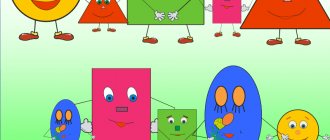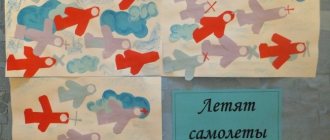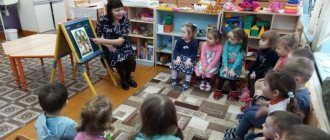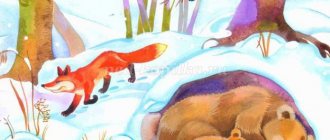Junior group. Early childhood, nursery. Children 1-4 years old
Summary of direct educational activities on the cognitive development of young children “New Year” Goal: to activate children’s knowledge about the New Year holiday by examining illustrations. Objectives: Educational: clarify and enrich children’s ideas about the upcoming event - the New Year holiday. Developmental: develop visual perception, speech and the ability to respond...
Summary of the game-activity “Train Engine” for children 2–3 years old
Goal: Expand social-emotional relationships between children, between a child and an adult. Objectives: -to develop the ability to show interest in game activities; - teach children to connect two or three game actions into a semantic chain, and verbally designate them. -encourage goodwill...
Summary of an open lesson in the second junior group of a preschool educational institution
Summary of an open lesson in the second junior group “Visiting grandma”
Objectives: educational:
Teach children to combine identical (by color, size) objects into subject sets according to a verbal task.
Continue to learn to distinguish and name geometric shapes: circle, square. Answer the question “how much?” many words, not one. Strengthen the ability to establish relationships between concepts: big, small. Work with children on various techniques and activities to develop fine motor skills. Continue to teach children to conduct a dialogue with the teacher: listen and understand the question asked and answer it clearly. Practice the ability to distinguish and name familiar geometric shapes: circle, square. To develop the ability to distinguish and name primary colors: red, blue, yellow, green. Use non-traditional drawing techniques (finger painting on semolina) in developing fine motor skills. developing:
develop logical thinking, memory, attention, fine motor skills.
Develop tactile sensitivity of complexly coordinated movements of fingers and hands in games with household items (clothespins, cereals). educating:
to cultivate a culture of behavior, goodwill, love for animals, the ability to work together and amicably.
Integration of educational areas:
• Communication • Socialization • Cognition (FEMP) • Cognition (FCCM)
Vocabulary activation:
• Geometric shapes (circle, square).
Materials for the lesson:
An easel with a sun drawn on it, balls (red, yellow, green, red), boxes (red, yellow, green, red), a hoop for balls, a river, large round and small round pebbles, large and square square ones small, soft toy - bunny, rooster, chicken, Christmas tree, house, clothespins, peas, beans, plates, semolina, chickens cut out of paper of different colors without tails, treats.
Progress of the lesson
The teacher leads the children into a group accompanied by music. Teacher: Children, look who came to us? Children: Sunny Teacher: Let's say hello to the sun. Children: Hello, sunshine! Educator: look how many guests we have, let’s say hello to them too, say hello. Children greet guests. Educator: Children, the sun did not come so easily, it will bid us on our way, but first it will give us a task. Look what's in my hand? Children: Ball Teacher: What color is the ball? Children: Blue Teacher: there are a lot of multi-colored balls in the hoop, and here the hoops are of different colors (red, yellow, blue, green). You need to arrange the balls according to the color of the hoop. Can we sort it out? Children: Yes Educator: Let’s begin Task No. 1 “Arrange the balls by color” Educator: Were there any balls in the hoop? Children: There were Educator: How many were there? Children: A lot Teacher: Are there any balloons now? Children: No balls Educator: Let's see if the balls are arranged correctly by color. What color is the hoop? green like grass and green balls, blue like the sea and blue balls, red like a tomato and red balls, yellow like the sun and yellow balls. Educator: We completed this task. Let's move on. We approached the river. Educator: Children, what is this? Children: River Teacher: There is no bridge here, but how can we get across? Look what pebbles are lying there. Round large pebbles and round small ones, square large ones and square small ones. And we need to choose large round pebbles. Task No. 2 “Assemble a bridge from large round pebbles” Educator: This is the kind of bridge you get. Has everyone collected large round pebbles? Children: Yes Educator: Look at the bridge they built. Let's walk. We guys need to cross the bridge, we will end up in a distant forest, there are friends and bunnies there. They end up in the forest Educator: Who is there? Children: Bunny Bunny: I am a bunny Teacher: Why are you sad? Bunny: I'm lost Teacher: where do you live? Bunny: At grandma's Teacher: Oh, bunny, we're also going to grandma's, don't worry, we'll see you off. The teacher looks behind the tree, and there is a toy bunny sitting there. Teacher: who is this, small, sad and crying? What happened to him? Bunny: This is a bunny, his owner abandoned him. Educator: The mistress abandoned the bunny, but we know the poem. Let's tell you. The teacher and the children recite a poem. Task No. 3 “Poem about a Bunny”
The Bunny was abandoned by the owner. The Bunny was left in the rain. He couldn’t get off the bench.
I was completely wet. Educator: don’t cry, bunny, don’t cry, we’ll take you to grandma too. Let's pet it. So that our bunnies don’t feel sad, let’s play with them. Musical game Educator: Well done! the bunnies had fun, and now let's move on, it's time for us to go, oh guys, what is this? Children: House A rooster is peeking out from the house Educator: Who is it? Children: Cockerel Educator: Let's listen to what the cockerel tells us. Rooster: I live in the yard, I sing at dawn, I have a comb on my head, I am a loud cockerel. Ku-ka-re-ku! Educator: Children, look at the color of the cockerel’s comb? Children: red Teacher: what color is the tail? Children: green Teacher: Petya the Cockerel, and we also know a poem about you Task No. 4 Poem “Peter the Cockerel”
Petya the Cockerel Golden comb Olive head Silk beard Why do you get up early Sing loudly Don’t you let the kids sleep?
Educator: This is a good poem. The cockerel has a family. Let's get a look. Who is this? Children: chicken Teacher: Is the chicken sad? What's happened? Chicken: “Ko ko ko.” She came to the chicken coop, climbed in, and plucked all the chickens’ tails. "Ko ko ko." Grief. Educator: Oh, don't worry. Children, let's help. Look how many chickens there are here, but they don’t have tails. Come on, we’ll make tails, but we’ll match each chicken’s tail by color. Task No. 5 “Chicken tails made from clothespins” Educator: Who made it? Show me the chicken. Well done! What color is the chicken? (red, yellow, blue, green) Educator: Children, the chickens need to be fed. Chickens love peas very much, but we got everything mixed up here with beans. Let's separate the beans from the peas. Task No. 6 “Sort beans from peas” Educator: The chickens will be happy. Well done, children! Let's give one plate of peas to the chickens so they can eat, and the chickens will come for the rest of the plates. Educator: Bunny, you don’t see anything, what does it look like? Bunny: To my grandmother’s house Educator : Children, we have come to my grandmother’s house, let’s go have a look. Grandma comes out of the house Grandma: Hello, guys! Educator: Hello, grandma! Grandma: Thank you for finding me, my bunny. Who helped you? Did someone help you find the way to my house? Educator: Grandma, we won’t tell you, we’ll show you. Task No. 7 “Drawing a sun from semolina” Grandma: What are you drawing, what does it look like? Circle, rays, what is this? This is the sun! It helped you find your way. Educator: That's right, grandma. This is the sun Grandma: Bunny, let's say thank you to the sun for helping the guys find the way to our house. Educator: Grandma, we came to visit you, to find out how your health is, how are you doing? Grandmother: Everything is fine, but I was worried there was no bunny, but you found it for me. Well done! Thank you! They showed me the way and brought me to me. And I prepared a treat for you. Grandmother distributes treats to children Educator: Thank you, Grandma! Our journey is over, it's time for us to go to kindergarten. Goodbye, grandma! Goodbye!
We recommend watching:
Summary of a drawing lesson in the 2nd junior group. Chicken Summary of educational activities for 2nd junior group. Vegetables Summary of an integrated lesson in the 2nd junior group. Summary of a lesson on speech development in the 2nd junior group. Working with Chukovsky's fairy tale
Similar articles:
Lesson notes for junior group 2
Leisure summary in the second junior group of the kindergarten “Celebration of the first braid”
Summary of GCD in the 2nd junior group on the topic “Our friend Snowman”
Summary of GCD in the 2nd junior group on the topic “Sea Adventure”
Summary of an integrated lesson in the 2nd junior group
MAGAZINE Preschooler.RF
Open lesson in mathematics in the 2nd junior group “Jungle” GOAL: formation of completed mathematical concepts in children of the 2nd junior group. OBJECTIVES: EDUCATIONAL: • Reinforce the concepts: one, many, long, short, high, low, wide, narrow, thick, thin. • Color (red, blue, green, yellow), shape (circle, square, triangle), size (large, small, medium). • Strengthen the ability to focus on 3 signs at the same time (color, shape, size). DEVELOPMENTAL: • Form attention, thinking, imagination, memory. • Develop auditory perception. • Develop fine motor skills. • Develop connected speech. EDUCATIONAL: • Cultivate goodwill, a sense of mutual assistance. • Cultivate neatness. INTEGRATION OF EDUCATIONAL AREAS: • Communication • Socialization • Cognition (FEMP) • Health • Safety • Artistic creativity • Music VOCABULARY ACTIVATION: • Geometric shapes (circle, square, triangle). • Names of vegetables and fruits. PRELIMINARY WORK: • Reading the fairy tale “Masha and the Bear”. • Didactic game. MATERIAL: • The envelope with the letter is attached to a helium balloon. • Envelope with a letter and geometric shapes. • Paths of multi-colored geometric shapes. • Artistic language (physical minutes, finger gymnastics). • Beads for Masha (knitted beads). • Magnetic board. • Baskets, vegetables and fruits. • Attributes for the forest (trees, bushes, mushrooms, flowers). • Music (Sounds of the forest, sound of the wind,). • Doll Masha. PROGRESS OF THE CLASS Playback: Today guests came to our lesson. Say hello to your guests. Well done! You should always say hello. This shows that you are well-mannered children. Playback: Guys, let's hold hands and make a small circle. “All the children gathered in a circle, I am your friend and you are my friend. Let’s hold hands tightly and smile at each other.” Let's raise our hands up and say hello to the sun, feel its warmth and give this warmth to each other. (lower your hands and blow on your palms) (unnoticed by the children, a helium balloon flies into the hall with an envelope with a letter attached to it) Play: Guys, look what it is ? Children: Balloon with a letter. Playback: Oh, what color is the ball? Children: Green ball. Vosp.: I wonder who the letter is from, what is written in it? Let's read it. "Hello my dear friends! I am writing this letter, Mashenka. I live in the village “Skazochka” with my grandparents. One day my friends and I went into the forest to pick mushrooms and berries. The forest turned out to be big. It's very beautiful in the forest. I got lost and lost. Now I can’t find my way home. I decided to write you a letter. I know that you are very kind and always help those in need. Help me too, please.” Vosp.: Guys, can we help Mashenka return home? Children: Yes! Vosp.: Did you recognize Mashenka, what fairy tale does she live in? Children: "Masha and the Bear." Vosp.: Then, we, too, will now go to the forest. (forest phonogram) Play: Let's say the magic words - “Turn around yourself and find yourself in the forest.” Vosp.: So we found ourselves in the forest. Look, guys, how beautiful it is in the forest. You like? Children: Yes! Playback: Tell me, what grows in the forest? Children: Trees, bushes, berries, mushrooms. Vosp.: Who lives in the forest? Children: Bears, wolves, foxes, squirrels, hedgehogs. Vosp.: What are the heights of trees? Children: Trees are high and low (show). Playback: How many trunks does a tree have? Children: The tree has one trunk. Playback: Oh, how many branches does the tree have? Children: The tree has many branches. Vosp.: Well done, guys. (wind soundtrack) Oh, do you hear what that noise is? The wind is probably picking up. Guys, what do trees do when it’s windy? Children: When the wind blows, the trees sway. Vosp.: Let us also sway like trees. Physical education lesson: The wind is blowing in our faces, The tree is swaying, The wind is quieter, quieter, quieter, The tree is getting higher, higher. Vosp.: Well, where is Mashenka? Oh, guys, look, Masha left us a message. There is written on the envelope from Mashenka. (Play opens the envelope, and there are geometric shapes) Play: Look, there are geometric shapes in the envelope. Repeat what is this? Children: Geometric shapes. Vosp.: That's right, well done guys, there are geometric shapes in the envelope. Playback: What geometric figure is this? Children: It's a circle. Playback: What geometric figure is this? Children: This is a square. Playback: What geometric figure is this? Children: This is a triangle Vos: And Masha also writes to us: - “Find paths consisting of such geometric shapes, the shortest path will show the way to find me.” Mashenka. (guys find tracks) Playback: There are 3 tracks here. Playback: What color is this track? (show) Children: Yellow. Vosp.: Well done, guys. Tell me, what figures does the yellow path consist of? Children: From squares. Playback: What color is this track? (show) Children: Blue. Play: Tell me, what figures does the blue path consist of? Children: From triangles. Playback What color is this path? (show) Children: Red. Vosp.: Tell me, what figures does the red carpet consist of? Playback: This means that the paths are different and differ in color, shape and size. Vosp.: Guys, haven’t we forgotten about Mashenka? Children: No. Vosp.: Which path should we take to find Mashenka? Children: We must take the shortcut. Playback: Which path is the longest or shortest here? (answers, showing children) Play. Well done boys. But you can pass this road only by jumping from one circle to another. Playback: Oh, guys, look what a beautiful flower meadow. Let's stop and smell the flowers. (squat, inhale, stand up, exhale) Play: Where is our Mashenka? Let's call her (awww, Mashenkaaa) Masha: I'm here. Hello guys. Children: Hello, Mashenka. Masha: Thank you guys for being so kind and coming to my aid. Vosp.: Mashenka, why are you sad? Masha: I got lost in the forest. Moreover, my beads fell apart. Vosp.: Don’t be sad, Mashenka, the guys will help you. Guys, can we help Mashenka collect new beads? Children: Yes! Playback: And now I’ll show you how to assemble the beads. First, I take a large ring and string it on a cord, and then I take a small ring and also string it, then again a large ring, followed by a small one, etc. These are the beads you should get. Playback: Mashenka, let’s check if the children assembled it correctly? (check and compare what is more, what is less, what needs to be done to make them equal). Vosp.: Well done, guys. Let's now play together with Masha. “Two claps above your head, Two claps in front of you, We’ll hide two hands behind your back, And we’ll jump on two legs.” Masha: Oh, guys, I feel so good and happy with you, I don’t even want to go home. But my grandparents are waiting for me. Vosp.: Mashenka, to get to home you must follow this stream, it will lead you to your village. Masha: Thank you guys for your help and for that I’m giving you fruit. Fruits are very healthy, they contain a lot of vitamins. Eat healthy! Goodbye, guys! Children: Goodbye Masha. Vosp.: Children and it’s time for us to return to kindergarten. What path did we take to get here? (they return, the player asks which path they took, which one they should return to, who did we help?)| Next > |





